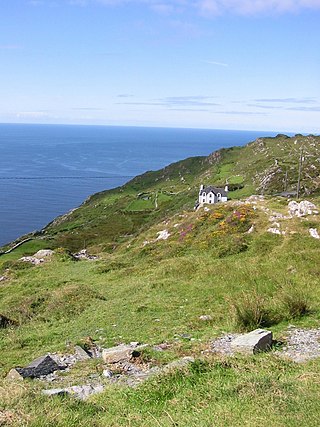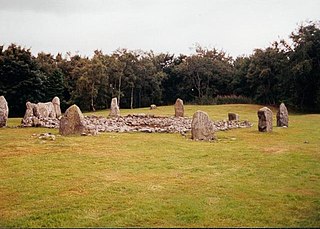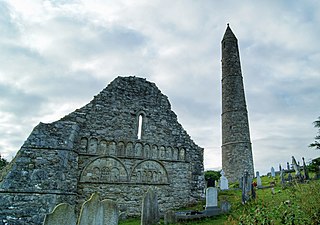
Stonehenge is a prehistoric monument on Salisbury Plain in Wiltshire, England, two miles (3 km) west of Amesbury. It consists of an outer ring of vertical sarsen standing stones, each around 13 feet (4.0 m) high, seven feet (2.1 m) wide, and weighing around 25 tons, topped by connecting horizontal lintel stones. Inside is a ring of smaller bluestones. Inside these are free-standing trilithons, two bulkier vertical sarsens joined by one lintel. The whole monument, now ruinous, is aligned towards the sunrise on the summer solstice and sunset on the winter solstice. The stones are set within earthworks in the middle of the densest complex of Neolithic and Bronze Age monuments in England, including several hundred tumuli.

Sheep's Head, also known as Muntervary, is the headland at the end of the Sheep's Head peninsula situated between Bantry Bay and Dunmanus Bay in County Cork, Ireland.

Durrus is a village and civil parish in West Cork in Ireland. It is situated ten kilometres (6 mi) from Bantry in County Cork, at the head of the Sheep's Head and the Mizen Head peninsulas.
The area surrounding Durrus village and civil parish has been inhabited since Neolithic times. The current layout of Durrus village, in West Cork in the south of Ireland, has its basis in developments during the 19th century.
Sir David Mackenzie Wilson, FBA is a British archaeologist, art historian, and museum curator, specialising in Anglo-Saxon art and the Viking Age. From 1977 until 1992 he served as the Director of the British Museum, where he had previously worked, from 1955 to 1964, as an assistant keeper. In his role as director of the museum, he became embroiled in the controversy over the ownership of the Elgin Marbles with the Greek government, engaging with a "disastrous" televised debate with Greek Minister of Culture Melina Mercouri.

Cullerlie stone circle, also known as the Standing Stones of Echt, is a small stone circle situated near Echt, Aberdeenshire. It consists of eight irregular stones of red granite arranged at approximately equal intervals to form a circle of 10.2 m (33 ft) diameter, enclosing the same number of small cairns. The cairns are characterised by outer kerbs or rings of stones, with a double ring surrounding the central cairn and a single ring in the others. All but one of the cairns have eleven ringstones, with the last having nine. The whole circle sits on a patch of gravel which forms the end of a low gravel ridge linking the site with Leuchar Moss. It is regarded as "a later development from the recumbent stone circle", though its layout with kerbed cairns within the circle makes it unique.
The Seven Monuments is an embanked stone circle and National Monument located in County Galway, Ireland.
Clodagh Standing Stones is a pair of standing stones forming a stone row and National Monument located in County Cork, Ireland.
Farranahineeny Stone Row is a stone row and National Monument located in County Cork, Ireland.
Breeny More Stone Circle is an axial stone circle and National Monument located in County Cork, Ireland.
Carrigaphooca Stone Circle is a stone circle and National Monument located in County Cork, Ireland. It is situated 4.4 km (2.7 mi) west of Macroom, immediately east of Carrigaphooca Castle, north of the N22, and near the confluence of the River Sullane and River Foherish. The name means "stone of the púca".
Maumanorig or Kilcolman is the site of the remains of a medieval Christian monastery and National Monument located on the Dingle Peninsula, County Kerry, Ireland.

Kilbennen or Kilbannon is a medieval ecclesiastical site and National Monument located in County Galway, Ireland.

Loanhead of Daviot stone circle is a recumbent stone circle in Aberdeenshire in lowland northeast Scotland. The circle consists of the recumbent stone with its flankers and a complete set of eight orthostats about 21 metres (69 ft) in diameter surrounding a low kerbed ring cairn which has an open court. However, the present appearance has in part been produced by substantial restoration after archaeological excavation in 1934, and in 1989 by the removal of the stones covering the central court.

Dunnideer stone circle is a mostly destroyed recumbent stone circle located near Insch in Aberdeenshire, Scotland. The three remaining stones lie close to the ruins of Dunnideer Castle. It is a scheduled monument.

St. Declan's Monastery, containing the remains of Ardmore Cathedral, is a former monastery and National Monument located in County Waterford, Ireland.








